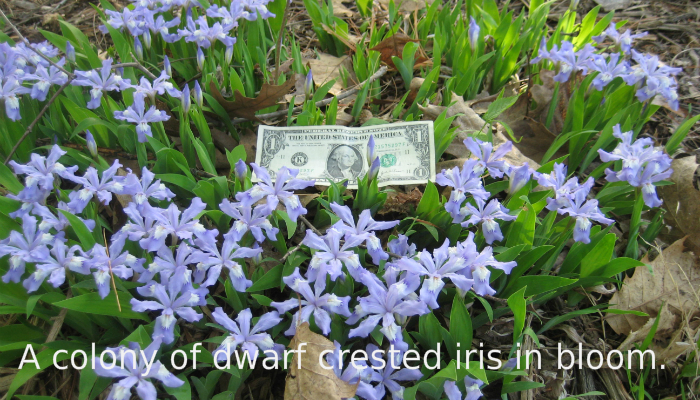Dwarf Crested Iris, A Rare Native Woodland Species

Like so much of our native flora and fauna, the core of the range for dwarf crested iris is southeast of us; and little disjunct populations extend into Iowa, Illinois, Ohio, and West Virginia.

The native distribution of dwarf crested iris.
Dwarf crested iris is a diminutive plant with little bladed leaves only six or seven inches tall. Like many native woodland species, its flowering period is brief and early, needing to complete much of its annual life cycle before the canopy closes. The flowers are small and delicate, only the size of a half dollar. But the individual plants spread out rather rapidly and in five years can develop into a colony about two feet in diameter. And because each colony is a clone, the entire colony blooms simultaneously, and so for a week it is an exquisite little cushion of miniature iris peeking out of last year’s fallen tree leaves.
I’ve only grown it in light to medium shade in a woodland setting, so I do not know how it handles a more domestic situation, or in full sun, or a rock garden. Readers can probably fill in this gap by sharing their experiences.
In the wild, its rhizomes are mostly located atop the soil surface, with just a few small roots going down into the soil. This might make it rather vulnerable to drying out if grown in full sun. This might also make it quite vulnerable to fire, and given that the original woodland landscapes of southeast Iowa burned rather often, fire might have limited its spread westward into the drier savanna ecosystems. They are also so shallow-rooted that with modern overgrazing, livestock simply kick the clones apart. But if you travel southeast toward the Appalachians, dwarf crested iris becomes an expected woodland species, alongside bloodroot, mayapple, and spring beauty.
The iris family is well distributed around the globe, with different species adapted from wetlands to desert, and tropics to boreal. In Japan there is a little iris quite similar to dwarf crested and it can handle full sun. The Japanese call it the roof iris, because in former centuries thatched roofs were common and this little iris was planted in the thatch, where its roots and rhizomes helped bind the layers of straw.
So dwarf crested iris is an uncommon native here, perhaps better adapted to the rarely burned woodlands of today, than to the more often burned ones in yesteryear. If you have, or manage, a woods where the garlic mustard is under control, this might be an interesting species to add. Once established, it is easy to propagate vegetatively in early spring by just digging out small sod chunks from a larger colony and transplanting them.


